Stari Most
Stari Most (Bosnian, Croatian and Serbian: Stari most, Serbian Cyrillic: Стари мост; lit. 'Old Bridge'), also known as Mostar Bridge (Turkish: Mostar Köprüsü), is a rebuilt 16th-century Ottoman bridge in the city of Mostar in Bosnia and Herzegovina that crosses the river Neretva and connects the two parts of the city. The Old Bridge stood for 427 years, until it was destroyed on 9 November 1993 by the Croatian Defence Council during the Croat–Bosniak War. Subsequently, a project was set in motion to reconstruct it; the rebuilt bridge opened on 23 July 2004.
Stari Most | |
|---|---|
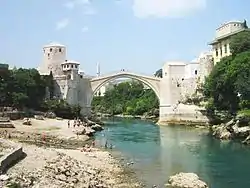 Stari Most in 2006 | |
| Coordinates | 43°20′13.56″N 17°48′53.46″E |
| Carries | Pedestrians |
| Crosses | Neretva |
| Locale | Mostar, Bosnia and Herzegovina |
| Official name | Stari most |
| Heritage status | KONS[1] |
| Characteristics | |
| Design | Arch |
| Material | Stone |
| Total length | 29 metres (95 ft) |
| Width | 4 metres (13 ft) |
| No. of spans | 1 |
| Clearance below | ca.20 metres (66 ft) at mid-span depending on river water-level |
| History | |
| Architect | Mimar Hayruddin (concept could originate from Mimar Sinan′s idea) |
| Constructed by | Mimar Hayruddin, apprentice of Mimar Sinan |
| Construction start | 1557 |
| Construction end | 1566 |
| Opened | 1566 |
| Rebuilt | 7 June 2001 – 23 July 2004 |
| Destroyed | 9 November 1993 |
| Official name | Old Bridge Area of the Old City of Mostar |
| Type | Cultural |
| Criteria | vi |
| Designated | 2005 (29th session) |
| Reference no. | 946 |
| Region | Europe |
| Location | |
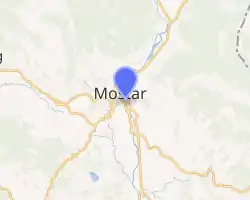 | |
The bridge is considered an exemplary piece of Balkan Islamic architecture and was commissioned by Suleiman the Magnificent in 1557. It was designed by Mimar Hayruddin, a student and apprentice of architect Mimar Sinan who built many of the Sultan's key buildings in Istanbul and around the empire.[2][3][4][5]
Characteristics
The bridge spans the Neretva river in the old town of Mostar, the city to which it gave the name. The city is the fifth-largest in the country; it is the center of the Herzegovina-Neretva Canton of the Federation of Bosnia and Herzegovina, and the unofficial capital of Herzegovina. The Stari Most is hump-backed, 4 metres (13 ft 1 in) wide and 30 metres (98 ft 5 in) long, and dominates the river from a height of 24 m (78 ft 9 in). Two fortified towers protect it: the Halebija tower on the northeast and the Tara tower on the southwest, called "the bridge keepers" (natively mostari).[1]
Instead of foundations, the bridge has abutments of limestone linked to wing walls along the waterside cliffs. Measuring from the summer water level of 40.05 m (131 ft 5 in), abutments are erected to a height of 6.53 metres (21 ft 5 in), from which the arch springs to its high point. The start of the arch is emphasized by a molding 0.32 metres (1 ft 1 in) in height. The rise of the arch is 12.02 metres (39 ft 5 in).[1]
History
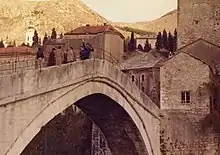
The original bridge replaced an older wooden suspension bridge of dubious stability. Construction began in 1557 and took nine years: according to the inscription the bridge was completed in 974 AH, corresponding to the period between 19 July 1566 and 7 July 1567. Little is known of the construction of the bridge, thought to have been made from mortar made with egg whites,[6] and all that has been preserved in writing are memories and legends and the name of the builder, Mimar Hayruddin. Charged under pain of death to construct a bridge of such unprecedented dimensions, Hayruddin reportedly prepared for his own funeral on the day the scaffolding was finally removed from the completed structure. Upon its completion it was the widest man-made arch in the world.
The 17th Century Ottoman explorer Evliya Çelebi wrote that the bridge "is like a rainbow arch soaring up to the skies, extending from one cliff to the other... I, a poor and miserable slave of Allah, have passed through 16 countries, but I have never seen such a high bridge. It is thrown from rock to rock as high as the sky."[7]
As Mostar's economic and administrative importance grew with the growing presence of Ottoman rule, the precarious wooden suspension bridge over the Neretva gorge required replacement. The old bridge on the river "...was made of wood and hung on chains," wrote the Ottoman geographer Katip Çelebi, and it "...swayed so much that people crossing it did so in mortal fear". In 1566, Mimar Hayruddin designed the bridge, which was said to have cost 300,000 Drams (silver coins) to build. The two-year construction project was supervised by Karagoz Mehmet Bey, Sultan Suleiman's son-in-law and the patron of Mostar's most important mosque complex, the Hadzi Mehmed Karadzozbeg Mosque.
Destruction

The Old Bridge was destroyed on 9 November 1993 in the War in Bosnia and Herzegovina, by shells fired by Croatian gunners. The destruction was ordered by Slobodan Praljak, a commander of Bosnian Croat forces, who was found guilty of the crime by the International Criminal Tribunal for the former Yugoslavia (ICTY).[8] The first temporary bridge on the traces of the Old Bridge was open on 30 December 1993; built in only three days by Spanish military engineers assigned to the United Nations Protection Force (UNPROFOR) mission.[9][10][11] The temporary structure was subsequently upgraded three times, to eventually link the shores with a more secure cable-stayed bridge until the proper reconstruction of the Old Bridge.[12][11]
Newspapers based in Sarajevo reported that more than 60 shells hit the bridge before it collapsed.[13] Croatian General and sentenced war-criminal, Slobodan Praljak, in attempt to absolve himself and his military units from responsibility and prosecution for the destruction of the bridge and other crimes committed during the war, published a document, "How the Old Bridge Was Destroyed", where he argues that there was supposedly an explosive charge or mine placed at the center of the bridge underneath and detonated remotely, in addition to the shelling, which caused the collapse. Most historians dismiss these claims, and disagree with its conclusions.[14]
After the destruction of the Stari Most, a spokesman for the Croats said that they deliberately destroyed it, because it was of strategic importance.[15] Academics have argued that the bridge held little strategic value and that its shelling was an example of deliberate cultural property destruction. Given that mosques, synagogues, and churches in Mostar were in proximity, the Old Bridge was targeted for the symbolic significance it served in connecting diverse communities.[16] Andras Riedlmayer terms the destruction an act of "killing memory", in which evidence of a shared cultural heritage and peaceful co-existence were deliberately destroyed.[13]
Reconstruction
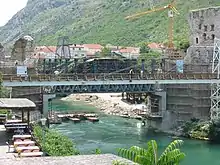
After the end of the war, plans were raised to reconstruct the bridge. The World Bank, the United Nations Educational, Scientific and Cultural Organization (UNESCO), the Aga Khan Trust for Culture and the World Monuments Fund formed a coalition to oversee the reconstruction of the Stari Most and the historic city centre of Mostar.[17] Additional funding was provided by Italy, the Netherlands, Turkey, Croatia and the Council of Europe Development Bank, as well as the Government of BiH.[17] In October 1998, UNESCO established an international committee of experts to oversee the design and reconstruction work.[17] It was decided to build a bridge as similar as possible to the original, using the same technology and materials.[17]
The bridge was re-built in two phases: the first one being led by Hungarian army engineers, consisting in the lifting of submerged material for its repurpose; and the second one being the removal of the temporary bridge, task assigned to Spanish army engineers, and the reconstruction of the Old Bridge with Ottoman construction techniques by a partnership of civil engineering companies led by the Turkish Er-Bu.[18][19][20] Tenelia, a fine-grained limestone, sourced from local quarries was used and Hungarian army divers recovered stones from the original bridge from the river below, although most were too damaged to reuse.[17][16][18]
Reconstruction commenced on 7 June 2001. The reconstructed bridge was inaugurated on 23 July 2004, with the cost estimated to be 15.5 million US dollars.[17][1][9]
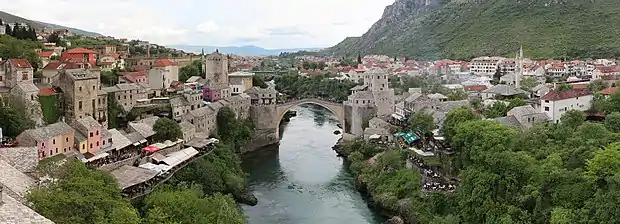
Diving
Stari Most diving is a traditional annual competition in diving organized every year in mid summer (end of July). It is traditional for the young men of the town to leap from the bridge into the Neretva. As the Neretva is very cold, this is a risky feat and requires skill and training,[21] though according to TripAdvisor, tourists do dive as well.[22] In 1968 a formal diving competition was inaugurated and held every summer. The first person to jump from the bridge since it was re-opened was Enej Kelecija.[23]
Since 2015, Stari Most has been a tour stop in the Red Bull Cliff Diving World Series.[24] In 2019 the diving was featured on Series 2, episode 3 of The Misadventures of Romesh Ranganathan.[25]
In popular culture
- Turkish rock band Bulutsuzluk Özlemi's 1996 song "Yaşamaya Mecbursun" (lit. 'You have to live') is about the destruction of Stari Most.[26]
See also
- List of bridges in Bosnia and Herzegovina
- List of World Heritage Sites in Bosnia and Herzegovina
- List of National Monuments of Bosnia and Herzegovina
- Tourism in Bosnia and Herzegovina
- Museum of the Old Bridge
- History of Bosnia and Herzegovina
References
- "Old Bridge (Stari Most) in Mostar - Commission to preserve national monuments". old.kons.gov.ba. Commission to preserve national monuments (KONS). 8 July 2004. Retrieved 25 June 2018.
- Balić, Smail (1973). Kultura Bošnjaka: Muslimanska Komponenta. Vienna. pp. 32–34. ISBN 9783412087920.
- Čišić, Husein (2007). Razvitak i postanak grada Mostara. Štamparija Mostar. p. 22. ISBN 9789958910500.
- Stratton, Arthur (1972). Sinan. New York: Charles Scribner's Sons. ISBN 9780684125824.
- Jezernik, Božidar (1995). "Qudret Kemeri: A Bridge between Barbarity and Civilization". The Slavonic and East European Review. 73 (95): 470–484. JSTOR 4211861.
- "Croats destroy historic bridge". The Independent. London, UK. Archived from the original on 2022-05-24. Retrieved 18 July 2015.
- "Saudi Aramco World: Hearts and Stones". saudiaramcoworld.com. Retrieved 2014-10-27.
- "Photo Gallery: Mostar, Then And Now". RadioFreeEurope/RadioLiberty. Retrieved 2022-08-24.
- Tecco, Simon (2004-07-24). "El Viejo Puente de Móstar vuelve a unir orillas y sentimientos". ABC (in Spanish). Retrieved 2020-11-22.
- Molina, Jorge. "Un puente para la paz" (mp4) (Documentary) (in Spanish). 31:41. Archived from the original on 2021-12-21 – via YouTube.
- UNESCO (January 2005). "Nomination Dossier "The Old City of Mostar"" (PDF). whc.unesco.org. p. 30.
- Ravn, Bente (1997-05-28). "Bridge over troubled waters". SFOR Informer Online. NATO. Retrieved 2020-11-22.
- Coward, Martin (2009). Urbicide: The Politics of Urban Destruction. London: Routledge. pp. 1–7. ISBN 978-0-415-46131-3.
- "Slobodan Praljak: Defending Himself by Distorting History :: Balkan Insight". www.balkaninsight.com. 4 December 2017. Retrieved 2017-12-07.
- Borowitz, Albert (2005). Terrorism for self-glorification: the herostratos syndrome. Kent State University Press. pp. 65. ISBN 0-87338-818-6.
- Dupré, Judith (2017). Bridges: A History of the World's Most Spectacular Spans (Google Books). New York: Hachette/Black Dog & Leventhal Press. ISBN 978-0-316-47380-4. Retrieved 2 March 2020.
- Armaly, Maha; Blasi, Carlo; Hannah, Lawrence (2004). "Stari Most: rebuilding more than a historic bridge in Mostar". Museum International. 56 (4): 6–17. doi:10.1111/j.1468-0033.2004.00044.x. S2CID 161607816.
- Taylor, David; Hannoun, Lionel; Molland, Halvor; Lehmann, Cristophe; Guner, Ender (2003-05-07). "The Old Mostar Bridge Project". SFOR Informer. NATO. 18, 19, 20, 23, 67.
- "Stari Most". Archived from the original on 2012-07-17. Retrieved 2012-07-17.
- Press Office of La Moncloa (2010-10-18). "Spain begins its final withdrawal from Bosnia after an 18-year mission". Government of Spain.
- "Bosnia's Bridge Divers Risk Their Necks for Tips and Thrills".
- "Jumping/Diving Mostar Bridge - Old Bridge (Stari Most), Mostar Traveller Reviews".
- "Chránený klenot" (in Slovak). Pluska. 15 Dec 2006. Archived from the original on 25 July 2011. Retrieved 4 May 2009.
- "Mostar - Red Bull Cliff Diving". Red Bull Cliff Diving. Retrieved 2 March 2020.
- "BBC Two - The Misadventures of Romesh Ranganathan - Episode guide". BBC.
- www.bulutsuzluk.com https://web.archive.org/web/20170630083227/http://www.bulutsuzluk.com/Icerik.asp?s=icerik&id=16. Archived from the original on 2017-06-30. Retrieved 2014-11-20.
{{cite web}}: Missing or empty|title=(help)
External links
- Rehabilitation Design of the Old Bridge of Mostar
- The Old Bridge / Stari Most - Commission to Preserve National Monuments of Bosnia and Herzegovina
- Live webcams from Stari most and the Old town. (mirror)


